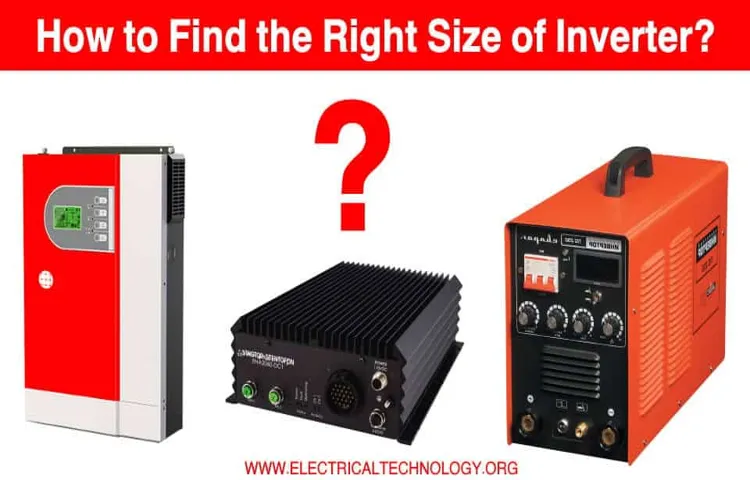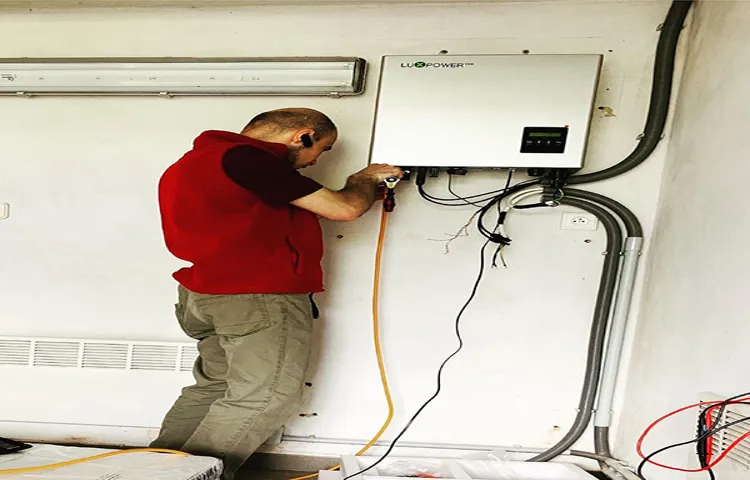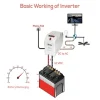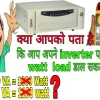Are you considering using a power inverter in your home to convert DC power from your batteries into AC power for your appliances and electronics? If so, you may be wondering how to determine the correct power inverter for your specific needs. Choosing the right power inverter is crucial to ensure that it can handle the electrical demands of your household without causing any damage or inefficiency. Oversizing or undersizing the inverter can lead to a number of issues, such as reduced efficiency, increased energy consumption, and even potentially damaging your appliances.
To determine the required power inverter for your home, you first need to assess your power needs. Think about the appliances and electronics that you plan to run on the inverter. Consider their power ratings, which are typically expressed in watts.
Next, add up the wattage of all the appliances and electronics that you plan to power simultaneously. This will give you an idea of the total power requirements of your system. Keep in mind that some devices may have a surge power rating, which is the amount of power they need to start up.
Make sure to factor in these surge power ratings as well. Once you have determined the total power requirements, you need to consider the inverter’s continuous power rating. This rating indicates the maximum power that the inverter can deliver continuously without any issues.
It is important to choose an inverter with a continuous power rating that is equal to or larger than the total power requirements of your system. Additionally, you may also want to consider the inverter’s peak power rating, which represents the maximum power that the inverter can deliver for a short period of time, usually a few seconds. This can be useful for devices with high surge power requirements.
In conclusion, determining the required power inverter for your home involves calculating the total power requirements of your appliances and electronics and choosing an inverter with a continuous power rating that can handle that load. By doing so, you can ensure that your power inverter operates efficiently and safely, providing you with reliable power for your home.
Table of Contents
What is a Power Inverter?
Are you looking to power your home during a blackout or when you’re off the grid? Then you’ll need a power inverter. A power inverter is a device that converts DC (direct current) power from a battery or solar panel into AC (alternating current) power that can be used to power household appliances. But how do you know how much power inverter you’ll need for your home? Well, it all depends on the size and power requirements of the appliances you want to run.
For example, if you want to power a refrigerator, a TV, and a few lights, you’ll need an inverter with a higher wattage rating. On the other hand, if you only need to power a few small electronics like laptops and phones, a lower wattage inverter will do the trick. So before purchasing a power inverter, make a list of the appliances you want to power and their power requirements, and then choose an inverter that can handle that load.
Introduction to power inverters and their function
power inverters, function, introduction

Factors to Consider
When determining how much power inverter is required for your home, there are several factors to consider. First and foremost, you need to calculate the total watts of power that will be needed to run the appliances and electrical devices in your house. This includes everything from your refrigerator and television to your air conditioner and light bulbs.
Once you have determined the total wattage, you can then choose an inverter that can handle that load. It’s important to keep in mind that the inverter should have a higher wattage rating than the total power consumption of your appliances, to account for any sudden or peak power demands. Additionally, you will also need to consider the voltage requirements of your appliances and ensure that the inverter you choose can meet those needs.
Overall, accurately determining the power requirements of your home and selecting an appropriate inverter is crucial to ensure that you have a reliable and efficient power supply.
Determining the Power Load of Your Home
Determining the Power Load of Your Home Factors to Consider
Assessing the Peak Power Rating
Assessing the peak power rating of a device is crucial when determining its performance capabilities. There are several factors to consider when evaluating the peak power rating of a device. One important factor is the power source.
The device’s power source should be able to provide enough power to meet the peak power requirements. Additionally, the device’s design and construction can impact its peak power rating. Devices that are designed to efficiently dissipate heat and manage power usage will have a higher peak power rating.
Another factor to consider is the device’s intended use. Different applications may have varying peak power demands, so it’s important to choose a device that can handle the specific requirements of the intended use. Finally, it’s important to consider any additional features or capabilities that the device may have.
Some devices may have built-in power management features or adjustable power settings that can optimize performance. By considering these factors, you can make an informed decision when assessing the peak power rating of a device.
Considering the Efficiency of the Inverter
“Inverter efficiency is an important factor to consider when choosing the right inverter for your energy system. The efficiency of an inverter determines how effectively it can convert the DC power from your solar panels into usable AC power. Higher efficiency means that less energy is wasted during the conversion process, resulting in more energy being available for use in your home or business.
When looking at different inverters, it’s important to compare their efficiency ratings. Look for inverters with high efficiency ratings, as this means that they are able to convert a larger percentage of the energy they receive into usable power. Ultimately, choosing an inverter with high efficiency can help to maximize the overall performance and output of your solar energy system.
“
Identifying the Preferred Inverter Type
solar inverter, inverter types, factors to consider, preferred inverter, system efficiency, budget constraints, energy requirements, installation location When it comes to choosing the right inverter for your solar system, it’s important to consider a few key factors. First, think about your energy requirements. Do you need an inverter that can handle a large amount of electricity? Or do you have more modest energy needs? This will help you determine the size and capacity of the inverter you need.
Another factor to consider is your budget constraints. How much are you willing to spend on an inverter? Keep in mind that different types of inverters have different price ranges, so it’s important to find one that fits within your budget. Additionally, think about the installation location of your solar system.
Depending on where you live, you may need an inverter that can withstand extreme temperatures or harsh weather conditions. Lastly, consider system efficiency. Some inverters are more efficient than others, which means they can convert a higher percentage of the sun’s energy into usable electricity.
By taking all of these factors into account, you’ll be able to identify the preferred inverter type for your solar system. So, before making a decision, carefully evaluate your energy needs, budget, installation location, and the efficiency of different inverter types.
Calculating the Power Inverter Size
Have you ever wondered how much power inverter is required for your home? Well, it all depends on your specific needs and the devices you plan on using. A power inverter is a device that converts DC power from a battery or solar panel into AC power that can be used to run household appliances. To determine the size of the power inverter you need, you need to calculate the total wattage of the devices you plan on using simultaneously.
This includes appliances like refrigerators, air conditioners, televisions, and lighting fixtures. Once you have the total wattage, you can double it to account for power surge and choose an inverter that can handle that load. It’s always good to have a little extra power capacity in case you want to add more devices in the future.
So, make sure to consider your power needs and calculate the right size of power inverter for your home.
Step-by-step guide to determining the required power inverter size
power inverter size. When determining the required power inverter size, there are a few factors to consider. The first is the power rating of the devices or appliances that you plan on using with the inverter.
Each device will have a wattage rating that indicates how much power it requires to operate. Make a list of all the devices you plan on using and their wattage ratings. Next, you’ll need to calculate the total wattage of all the devices combined.
Simply add up all the wattage ratings to get the total power requirement. Once you have the total wattage, you’ll need to factor in any power surges or spikes that may occur. Some devices, such as refrigerators or air conditioning units, may require a higher power output to start up.
To account for this, it’s recommended to add an additional 20% to the total wattage. Once you have the total wattage including the additional 20% for power surges, you can then choose an inverter that can handle that power load. Inverters are typically rated in terms of their maximum continuous and peak power output.
The continuous power rating indicates the amount of power the inverter can sustain for long periods of time, while the peak power rating indicates the maximum power it can handle for short bursts. To ensure that the inverter can handle your power requirements, it’s recommended to choose an inverter with a continuous power rating that is higher than the total wattage of your devices, including the additional 20% for power surges. This will give you some room for flexibility and prevent overloading the inverter.
Overall, calculating the required power inverter size involves considering the wattage ratings of your devices, accounting for power surges, and choosing an inverter with a continuous power rating that can handle your total power load. By following these steps, you can ensure that you have the right size inverter for your needs.
Selecting the Right Power Inverter for Your Home
When it comes to selecting the right power inverter for your home, determining how much power you require is crucial. The power capacity of an inverter is typically measured in watts (W) and can determine what appliances and devices you can operate during a power outage. To calculate the power load, you need to consider the total wattage of all the appliances and devices you plan to connect to the inverter simultaneously.
Add up the wattage of each item to determine the peak power load. It’s also important to consider the surge power rating of the inverter, which indicates its ability to handle sudden power demands. This is especially important for devices with motors, like refrigerators and air conditioners, which often require a higher starting power.
By selecting an inverter with a power capacity slightly higher than your peak power load, you can ensure you have sufficient power to keep your essential appliances running smoothly.
Exploring various power inverter options
power inverter, home power inverter, selecting the right power inverter Are you considering installing a power inverter in your home? If so, it’s essential to select the right power inverter that meets your specific needs. Power inverters are devices that convert DC power (usually from a battery) into AC power, allowing you to run household appliances and electronics when you’re off the grid or during a power outage. When choosing a power inverter, there are several factors to consider.
First, determine how much power you will need. Calculate the combined wattage of the devices you plan to run simultaneously, and choose an inverter that can handle that load. Additionally, consider the inverter’s wave output.
Pure sine wave inverters provide clean, reliable power and are suitable for most appliances, while modified sine wave inverters are more affordable but may not be compatible with certain devices. It’s also essential to consider the input voltage and battery capacity required by the inverter. Overall, finding the right power inverter for your home involves considering your power requirements, wave output, input voltage, and battery capacity.
By doing so, you can ensure that you have a reliable source of power when you need it most.
Choosing the suitable inverter based on your power consumption
power inverters, inverter selection, power consumption, inverter for home
Conclusion
So, my dear readers, we have come to the end of our journey to find out how much power inverter is required for a home. Throughout this exploration, we have encountered various factors that determine the size of the inverter needed – from the number and type of appliances to the duration and frequency of usage. But fear not! I am here to distill all this information into a single elegant conclusion – the power inverter required for a home is like a magical genie.
It grants your wish for uninterrupted electricity, making sure all your favorite appliances keep humming, even during a power outage. Just like Aladdin’s genie, the power inverter comes in different sizes and capacities – from the small, compact models that can power a few essential appliances to the mighty, behemoth inverters that can handle all your energy needs. But here’s the clever twist – unlike the genie, you don’t need to rub a lamp to get your perfect inverter.
Instead, you can rely on a simple formula: Wattage = Voltage x Amperage. By calculating the total wattage of your appliances and devices, you can determine the power inverter’s capacity you need. However, choosing the right inverter is not just about raw calculations.
It’s also about understanding your lifestyle and priorities. Are you someone who can’t function without their morning coffee? Then you’ll definitely need an inverter that can power your precious coffee machine. Or maybe you’re a movie buff and can’t bear the thought of missing the latest blockbuster? Well, you better invest in an inverter that can handle your home theater system’s power demands.
In the end, the power inverter becomes more than just a piece of equipment – it becomes your own personal power superhero, saving you from the darkness of blackouts and keeping your home running smoothly. So, my friends, remember this delightful analogy – the power inverter is like a magical genie, ready to grant all your electricity wishes. Choose wisely, and may your home always be filled with light and power, thanks to your trusty power inverter!”
Understanding the necessities of a power inverter for your home
power inverter, select the right power inverter, necessities of a power inverter
FAQs
How do I calculate the power inverter required for my home?
To calculate the power inverter required for your home, you need to determine the total power consumption of your appliances and devices. Add up the wattage of each individual device and appliance, taking into consideration both their rated power and starting power. Once you have the total power consumption, choose an inverter that can handle at least that amount.
What factors should I consider when choosing a power inverter for my home?
When choosing a power inverter for your home, you should consider factors such as the total power consumption of your appliances, the surge power requirements (if any), the inverter’s output voltage and frequency compatibility with your household appliances, and the inverter’s efficiency and reliability.
Can I use a power inverter to run my entire home?
It depends on the power consumption of your home and the capacity of the power inverter. In most cases, power inverters are not designed to handle the entire electrical load of a home. They are usually used as a backup power source for essential appliances or for powering small devices or tools.
What size power inverter do I need for running my refrigerator?
The size of the power inverter you need for running your refrigerator depends on its power consumption. Check the refrigerator’s specifications or label for the rated power (in watts) or the current (in amps) it requires. Choose an inverter that can handle at least that amount, and consider any additional power required during startup.
Can a power inverter be connected to solar panels to provide clean energy for my home?
Yes, a power inverter can be connected to solar panels to convert the DC (direct current) output from the panels to AC (alternating current) for use in your home. This allows you to harness clean solar energy for your electrical needs and even sell excess energy back to the grid.
How can I protect my sensitive electronic devices when using a power inverter?
To protect sensitive electronic devices when using a power inverter, you can use a surge protector or an uninterruptible power supply (UPS). These devices help regulate the power output, filter out any voltage fluctuations or spikes, and provide backup power in case of power outages or disruptions.
Are modified sine wave inverters suitable for all types of appliances?
Modified sine wave inverters are suitable for most household appliances and devices. However, certain sensitive or specialized equipment, such as medical devices, some refrigerators, certain audio or video equipment, and some digital clocks or timers, may not function properly or may experience reduced performance when using a modified sine wave inverter. In such cases, it is recommended to use a pure sine wave inverter.



